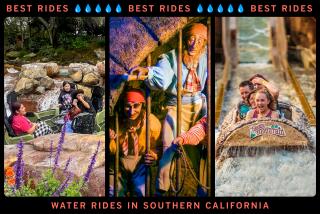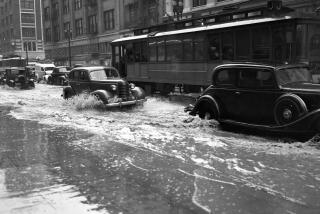I Think It Might Rain
The weather of Joe Sirard’s childhood was one vast teachable moment, as big as the cloud-spotted sky he made a habit of peering up at. He kept a weather journal. He named the storms of his youth, making them his own like so many baseball cards.
“I still recall what I dubbed the ‘northwest blizzard of ‘81,’ in which strong northwest winds and heavy snow affected my hometown of Oxford, Mass.,” says Sirard, who was 15 that December day. “As you can well imagine, I was a weather freak, a weather geek, a weather weenie. Actually, I still am.”
The boy who kept a record of “nasty and notable weather events” grew up to be a meteorologist for the U.S. National Weather Service in Oxnard. As he ticks off the wonders--yes, wonders--of Southern California’s weather, he sounds as if he’s trying to convince the folks back home of the need for weather forecasters here.
“The wide variety of weather is in stark contrast to the picture of beautiful, sunny weather 365 days a year that people in other states envision we have,” Sirard proclaims.
There are plenty of moments for parent and child to peer up at the sky.
These 15 rainy-day things to do look for the silver lining in coming (or ending) rainstorms by linking the activity, however subtly, to weather or water. Chase after rain beetles whose relatives were held sacred by ancient Egyptians or watch a chimpanzee prance around puddles. Dodge the drizzle while wielding a sand pail at a thoroughly dry indoor beach.
Seize the deluge and turn it into a teachable moment.
Marsh Madness: Without the rain, the Madrona Marsh Preserve in Torrance wouldn’t exist. Spring is prime time at the 50-acre preserve just east of the Del Amo Fashion Center.
“It’s a unique experience for a city. We’ve got a pretty good pond of water out there right now,” says Walton Wright, a naturalist with the city of Torrance, who admits to pumping water in to raise the water level when nature doesn’t do the job.
While the kids like to catch tree frogs, the adults prefer bird-watching, Wright says. On a recent winter day, about 150 mallards dotted the marsh, which covers about 16 acres when flooded. On March 11, one-hour canoe rides will be given from 9 a.m. to 5 p.m.; reservations are recommended.
“We’ll get 10 or 12 canoes out there and paddle all around the cattails,” Wright says, “But most of the ducks flip out and get scared away.”
* Activities and classes meet at the Temporary Natural History Center, 3201 Plaza Del Amo Blvd., Torrance. Call (310) 782-3989 or visit https://www.tprd.torrnet.com/marsh.htm.
Sleep With the Fishes: If you’re waterlogged, you might as well have some pretty big company. Join “Lifestyles of the Fish and Famous,” the Long Beach Aquarium of the Pacific’s Friday night family sleepovers for ages 5 and up. Bring your sleeping bag and settle in to spend the night in front of the aquarium’s 350,000-gallon tropical reef exhibit.
While surrounded by more than 12,000 ocean animals, you’ll learn that land-based families aren’t the only ones that struggle with relationships. “The ocean is full of animals that depend on family members to teach them survival strategies; it is also full of animals that depend on odd friendships throughout their lives,” says a release describing the program.
* Long Beach Aquarium of the Pacific, Shoreline Drive and Aquarium Way, Long Beach. Next sleepovers are Feb. 9 and March 9. Preregistration required. $50 per person. (562) 951-1630.
Animated Animals: Cooler weather makes the animals at the Los Angeles Zoo more active, and rain makes some of them practically want to dance, says Lora LaMarca, a zoo spokeswoman.
“When it rains, we leave their bedroom doors open, and they can come out or stay in. The great apes, chimpanzees, gorillas, especially the young ones, like to play in the showers,” she says.
She recommends dressing for the weather because the zoo’s only true indoor enclosure is the koala house. An indoor concession stand also provides refuge from the rain.
* Los Angeles Zoo, Griffith Park at Ventura and Golden State freeways. (323) 644-6400.
More Wild Things: The same wet-is-wilder theory applies at San Diego Wild Animal Park, where the hard-to-see lions and tigers that are usually more active at night rise for the wet weather.
“When the rain is a little warm, the primates also get really active and play, and that can be great fun to watch,” says Christina Simmons, a park spokeswoman. “The animals are running around playing, enjoying the change in the weather.”
The animals, kept in outdoor field enclosures, also can be viewed from the relatively weatherproof monorail tour, with open sides and a rain-repelling roof.
* San Diego Wild Animal Park, 15500 San Pasqual Valley Road, Escondido. (619) 234-6541 or (760) 747-8702.
Fantasy Land: Disneyland in a downpour? Savvy park-goers know people stay away in droves when it rains on Main Street U.S.A.
“It is, without a doubt, a wonderful time to come. There are fewer people in the park,” says a spokeswoman. “There’s always a probability some rides will close, like the Matterhorn, because of the weather, but there’s still so much to do.”
Wear clothes that tend to shed water, boots to keep your feet dry and use a poncho or hooded raincoat instead of an umbrella, to keep your hands free, she advises.
* Disneyland, Ball Road at Santa Ana Freeway, Anaheim. (714) 781-4565.
Into the Mist: Sometimes, all it takes for a child to revel in the rain is a puddle to splash in and a working umbrella, accompanied, of course, by a parental lecture about how opening an umbrella indoors causes bad luck. If you want to raise the bar, consider taking a hike at a park or canyon--as long as it’s just misting.
“If it’s really raining, people are putting themselves in danger, and we do not recommend going out,” says Judy Burns, director of the Children’s Nature Institute in Santa Monica. “But in heavy fog or a light mist, it can be magical. The leaves glisten.
“If it really rains, the animals hole up, and afterward they come out to feed. After a rain, everything is more intense. Everything has been cleaned by the rains.”
To hike in a light rain, wear sensible shoes, stay near trail heads and away from dry stream beds, because they can quickly fill with water, Burns says.
The institute schedules walks in Temescal Canyon, Franklin Canyon, Will Rogers State Park and Malibu Lagoon, among other places. Extremely rainy weather cancels walks, but the majority take place.
* Find information on specific Children’s Nature Institute walks at https://www.childrensnatureinstitute.org, or call (310) 364-3591.
Time Warp: If you really want to slow down time, spend the entire rainy day at home coopedup with your kids, or head on over to see Kidspace Museum’s new exhibit, “Tick Tock Beyond the Clock.”
“Time is a really hard thing for kids, and sometimes even adults, to get their hands around,” says Roy Mueller, the museum’s director of education. The interactive exhibit explores the concept of time through two characters, Tick and Tock. Follow Tick to see how clocks tick, follow Tock to see how time brings changes in the season. One interactive exhibit is a larger-than-life hourglass filled with birdseed that runs out after one minute.
The most popular exhibit is Inter-Antics, a 17-foot climbing structure that simulates the environment of a rain-cutter ant you might find in the South American rain forest. “It’s one of those safe-danger places,” Mueller says. “The kids can go really high up, and it gives them an overview of the world that they normally don’t get because they are 3 or 4 feet tall.”
Also popular at the museum: Eco-Beach, a 250-square-foot indoor beach that includes a freshwater aquarium with fish, a hermit crab tank and sand pails for the scoop-and-pour set.
* Kidspace Museum, 390 S. El Molino Ave., Pasadena. (626) 449-9144.
Bird Land: One of Jess Morton’s favorite bird walks occurred just after a light rain at the South Coast Botanic Garden on the Palos Verdes Peninsula. The president of the Palos Verdes/South Bay Audubon Society led a walk for which one person showed up. “Everybody said, ‘Don’t go out in this,’ but the birds were spectacular. We saw some very rare birds, a rose-breasted grosbeak and some bobolinks,” Morton recalls.
Birding can be good in a light rain or just after a storm because insects and worms forced out of the ground provide a good opportunity for birds to eat, Morton says. He recommends seeking any good green space, possibly with a canyon trail, because canyons provide birds shelter during the rain.
Depending on the season, a fair number of birds can also be spotted at the Madrona Marsh Preserve. Many people look for migratory birds in the fall and spring, and an average of 150 to 175 types of birds are spotted at the preserve each year, says naturalist Wright.
* Find more information about the Palos Verdes/South Bay Audubon Society at https://www. lmconsult.com/pvaudubon.
Cool Currents: A computer at the Discovery Science Center is devoted to weather-related phenomena, including hurricanes, tornadoes, thunderstorms and winter storms. After the weather lesson, the kids can try on a “blubber mitt”; the name alone is sure to elicit a giggle. The baseball-like glove made of animal skin shows how animals keep warm in the cold.
Other weather encounters among the 100 exhibits: A small-scale version of a tornado in an 8-foot-tall tunnel and an interactive exhibit that allows visitors to release a cloud ring (water vapor) and watch it rise to the ceiling.
* Discovery Science Center, 2500 N. Main St., Santa Ana. $9.50, ages 3 to 17, $7.50. (714) 542-CUBE.
Artists at Work: Rain or shine, “Sculpture With Shahin” takes place at the Sooky Goldman Nature Center in Franklin Canyon Park above Studio City. Sculpture artist Shahin Atigheh leads a two-hour class in which participants work with oil-based clay.
“It’s very therapeutic to put your hands on clay,” says Angi Bates, who works at the center. “There are no rules. She just lets it happen. It’s a fun and creative class.”
Because of the center’s setting in a 605-acre park, many people in the ongoing class sculpt natural subjects. And if the rain’s not too heavy, “people are welcome to come in and slosh around,” Bates says.
* “Sculpture With Shahin,” Sundays, 2 to 4 p.m., William O. Douglas Outdoor Classroom/Sooky Goldman Nature Center, 2600 Franklin Canyon Drive, L.A. Call (310) 858-3090.
Meet the Beetles: Rain beetles spend less than 1% of their 12-year life span above ground, which can make them pretty hard to spot, says Brent Karner, coordinator of the Natural History Museum’s insect zoo. Rain beetles are scarabs, part of the family of beetles that includes the dung beetle, an insect honored by ancient Egyptians.
Your best chance of glimpsing the beetles is on hiking trails in the San Gabriel Mountains, the Angeles National Forest or the Santa Monica Mountains. The earlier in the day and the wetter it is, the better your chances.
“They are some of the most beautiful beetles around,” Karner says. “If they are out, they fly in very low, sweeping patterns. They look to a lot of people like big bumblebees.”
Jungle Fever: The simulated rain forest at the Natural History Museum is a replica of much of what you’d find in the real one, says Robert Reid, a museum muralist who traveled to Peru to make molds and collect “leaf litter” on the rain forest floor.
Visitors experience a blast of South American heat upon entering the two-story exhibit filled with the sounds of a waterfall and wildlife taxidermy. One area displays the burned stumps of a forested area, complete with attendant erosion.
“It’s the next best thing to going there,” Reid says of the decade-old exhibit. “Even the safety rails are camouflaged to look like forest vines.”
* Natural History Museum of Los Angeles County, 900 Exposition Blvd., L.A. (213) 763-DINO.
Amazon Art: The rain forest is also coming to the Kidseum at the Bowers Museum of Cultural Art as a Saturday morning art class in which children will create their own miniature rain forest “filled with flying, crawling and slithering creatures living in a canopy of flora,” says Karen Sirmenis, a museum spokeswoman.
Participants will make three-dimensional, stuffed-paper representations of animals and explore painting and drawing techniques as well as mixed-media sculpture. The class at 10 a.m. March 17 is one of many regularly scheduled Saturday and Sunday “Art Adventures.”
* Bowers Museum of Cultural Art, 2002 N. Main St., Santa Ana. (714) 567-3600.
Water World: After the storm clears, show the kids awe-inspiring waterfalls exist in the real world, not just in the “Emperor’s New Groove.” “Afoot and Afield in Los Angeles County,” by Jerry Schad (Wilderness Press, 2000, $16.95), will point you to dozens of hidden waterfalls, many of them in the Angeles National Forest. The Santa Monica Mountains Conservancy Web site, https://www.ceres.ca.gov/smmc/filming.htm, includes a section on “dramatic waterfalls” complete with an only-in-L.A. information number--for filming permits.
Whither Weather: Don’t want to venture out? Learn about the weather via the Web. “There’s so much stuff, on a rainy day a kid could spend all day looking things up on the Internet,” Sirard says. “If you went on a search engine and typed in ‘weather’ there would be thousands and millions of hits.’ ”
For a more manageable entry point, turn to https://www.nwsla.noaa.gov, the Web site of the National Weather Service office for Los Angeles and Oxnard. The site includes satellite and radar data, road conditions, sunrise and sunset times, forecasts, jet stream maps, dozens of weather-related links and a category every kid can relate to: “New Stuff.”
*
What You Can Do at Home
* Five low-tech activities to build on your child’s curiosity about the rain. Page 8
More to Read
Sign up for The Wild
We’ll help you find the best places to hike, bike and run, as well as the perfect silent spots for meditation and yoga.
You may occasionally receive promotional content from the Los Angeles Times.







